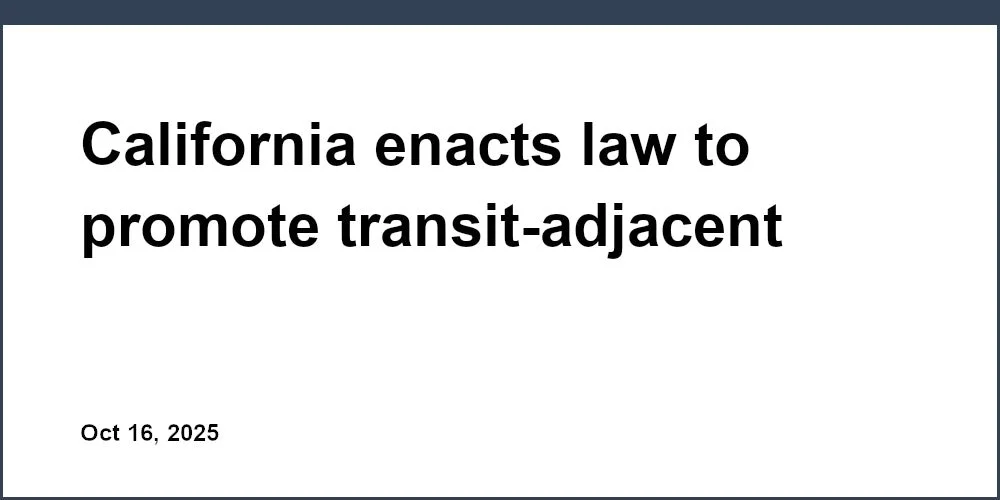California enacts law to promote transit-adjacent multifamily housing construction
California Governor Gavin Newsom has signed Senate Bill (SB) 79 into law, paving the way for increased multifamily housing construction near major transit hubs. This landmark legislation seeks to address the state's persistent housing crisis by allowing denser development in neighborhoods currently dominated by single-family homes, provided they are within a quarter-mile to a half-mile of rail, subway, or bus rapid transit stops.
"For too long, California has poured billions into transit without building the housing density needed for those systems to reach their potential", Newsom stated in a press release. "SB 79 helps change that by focusing more homes near rail stations - boosting ridership, cutting traffic and pollution, lowering household costs, and expanding access to jobs, schools, and services."
A Decade-Long Effort Comes to Fruition
The passage of SB 79 marks the culmination of nearly eight years of advocacy by its author, San Francisco State Senator Scott Wiener. The bill, originally introduced in 2018, faced three failed attempts before finally passing both the state Senate and Assembly earlier this year. It is set to take effect on July 1, 2026.
"It’s a huge step for housing in California", Wiener wrote on X (formerly Twitter) following the bill's signing. "It’ll create more homes, strengthen our transit systems, and reduce traffic and carbon emissions."
The new law will initially apply to eight major California cities: Los Angeles, San Diego, Orange, Santa Clara, Alameda, Sacramento, San Francisco, and San Mateo. It requires changes to local zoning laws to allow for five- and six-story apartment buildings near specific transit stops, but also permits local governments to propose alternative transit-oriented development plans, provided they meet the required housing density targets within two to three years. Low-income communities may defer implementation to allow for additional planning time.
The Debate Over Local Control
While SB 79 has been hailed by supporters as a pro-housing milestone, critics argue it undermines local control. Los Angeles Mayor Karen Bass and several community groups voiced opposition to the bill, citing concerns about its potential to erode local authority and disrupt neighborhood character.
"[The bill would] erode local control, diminish community input on planning and zoning, and disproportionately impact low-resource neighborhoods", Bass said in a statement reported by LAIST in September.
Danna Givot, vice chair of Neighbors for a Better San Diego, echoed these concerns, arguing that SB 79 could harm property values and fail to deliver the promised benefits. "The homeowners will suffer, the neighborhoods will suffer, there will be no infrastructure provided to support that kind of density, up to a mile from transit, and transit will continue to be subsidized because it will not have increased ridership based on the way Senate Bill 79 has been written", she told NBC San Diego.
Supporters, however, dismiss these arguments as obstructionist. Los Angeles real estate agent Brock Harris remarked, "SB 79 puts density where it belongs - near transit infrastructure we’ve already paid for."
Challenges Ahead
Though the law is a step toward increasing housing availability in California, experts caution against expecting immediate results. Rising construction costs, labor shortages, and permitting delays remain significant hurdles to large-scale development.
Hannah Jones, a senior economic research analyst at Realtor.com, highlighted these challenges. "Actual construction may be slow to materialize, given rising building costs, labor shortages, and financing constraints", she said. Jones also noted that while the law aims to make housing more affordable, there are no guarantees that new developments will meet that goal, raising concerns about potential displacement.
Victor Currie, a real estate agent at Douglas Elliman Real Estate in Los Angeles, questioned whether many transit-adjacent areas - often in more expensive neighborhoods - would see affordable housing emerge. "[The law] threatens to ruin the character that drew people to certain neighborhoods in the first place", Currie said, adding, "Just because it would become theoretically easier to get projects approved doesn’t mean that it’s economically viable to build anything other than luxury projects in a lot of these areas."
Nonetheless, advocates view SB 79 as a critical step toward addressing the state's housing shortage. "We’ve been banning housing precisely where it makes the most sense to build", said Harris. "Until [challenges like financing costs and permitting delays] are rectified, bills like SB 79 will help but not solve the housing crisis."
Looking Forward
SB 79 underscores California’s alignment with the "Yes In My Back Yard" (YIMBY) movement, which promotes zoning changes to encourage affordable and diverse housing. Brian Hanlon, CEO of California YIMBY, praised Governor Newsom for his leadership on the issue. "With his signature on SB 79, Governor Newsom cements his legacy as one of the most transformative pro-housing leaders in California history", Hanlon said. "Now we begin the work of making sure its provisions are fully and fairly implemented."
While the law’s long-term effects remain uncertain, SB 79 represents a significant effort to reshape California’s housing policies by prioritizing density near public transit. Whether this will translate into meaningful relief for the state’s housing crisis depends on how local governments, developers, and communities respond in the years ahead.

